Abstract
By use of 14C-labeled benzyl penicillin, it has been established that β-lactamases and/or acylases play no role in the resistance of Neisseria gonorrhoeae to penicillin. It has been found, however, that very susceptible strains of the organisms (minimal inhibitory concentration, 0.008 μg/ml) bind 10 to 15 times as much penicillin as do moderately to highly resistant strains of the gonoccoccus (minimal inhibitory concentration, 0.125 to 2.0 μg/ml). It is postulated that this degree of change in binding components of the whole cell and whole cytoplasmic membrane is sufficient to account for the decreased susceptibility of the organism to penicillin.
Full text
PDF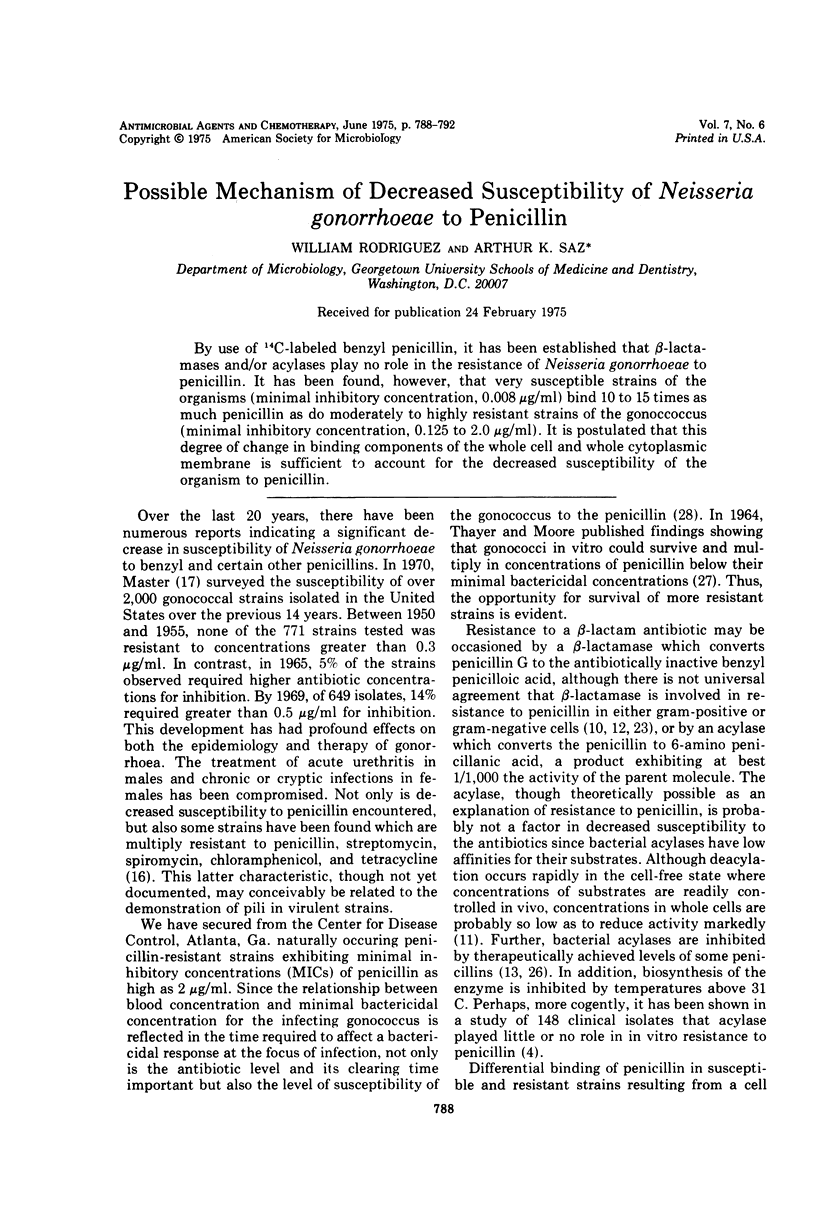
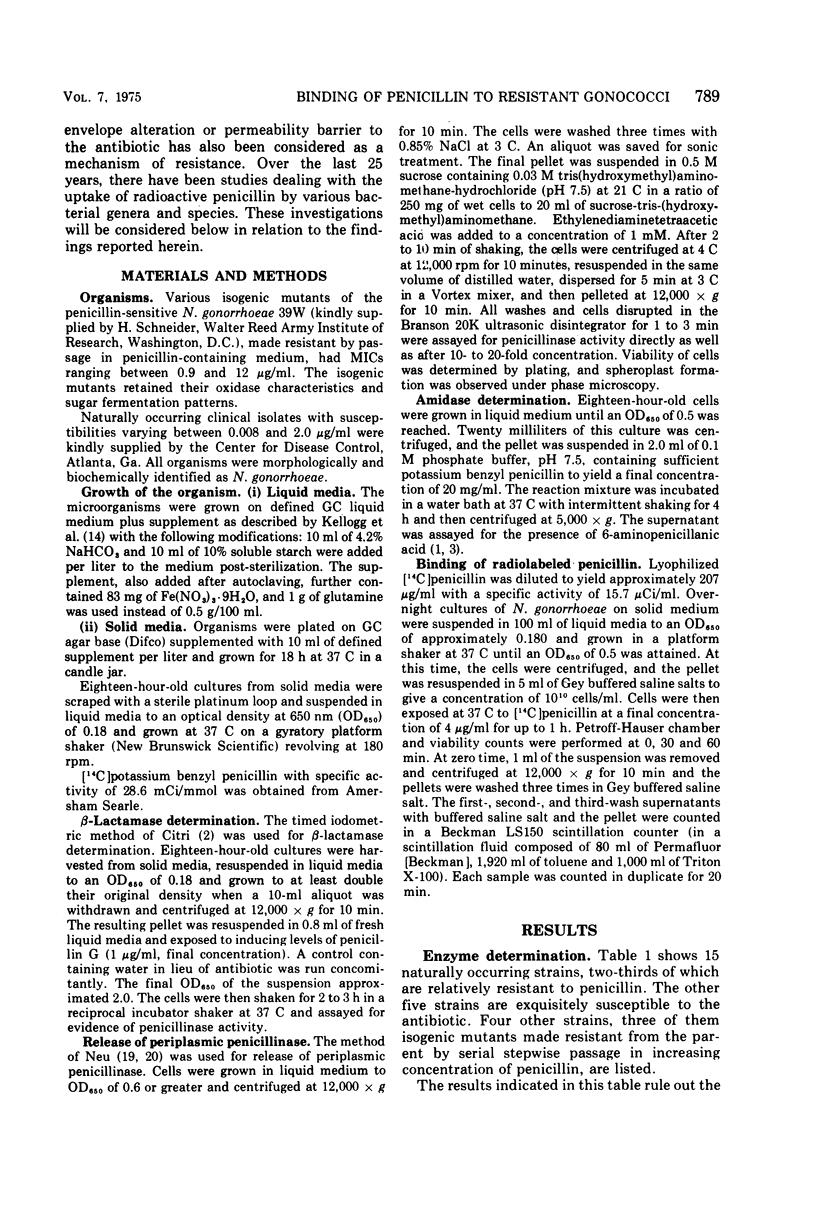
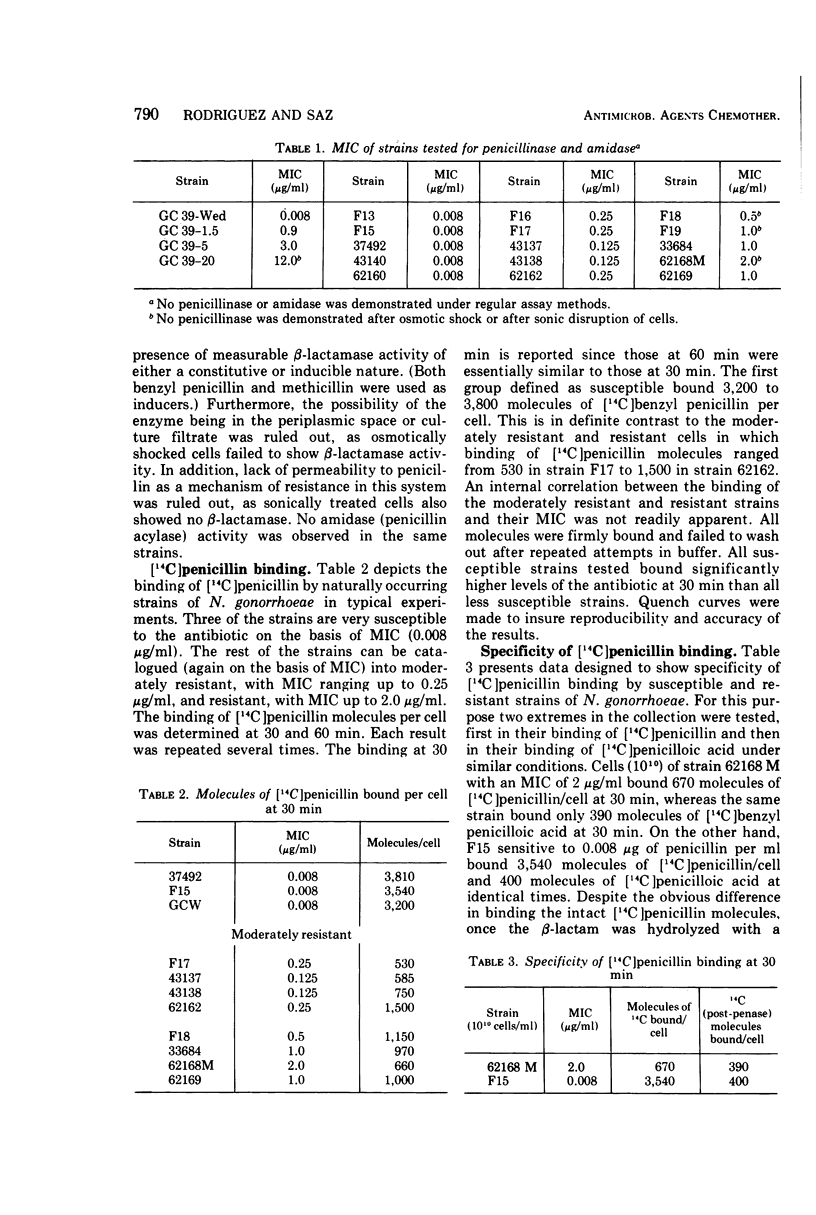
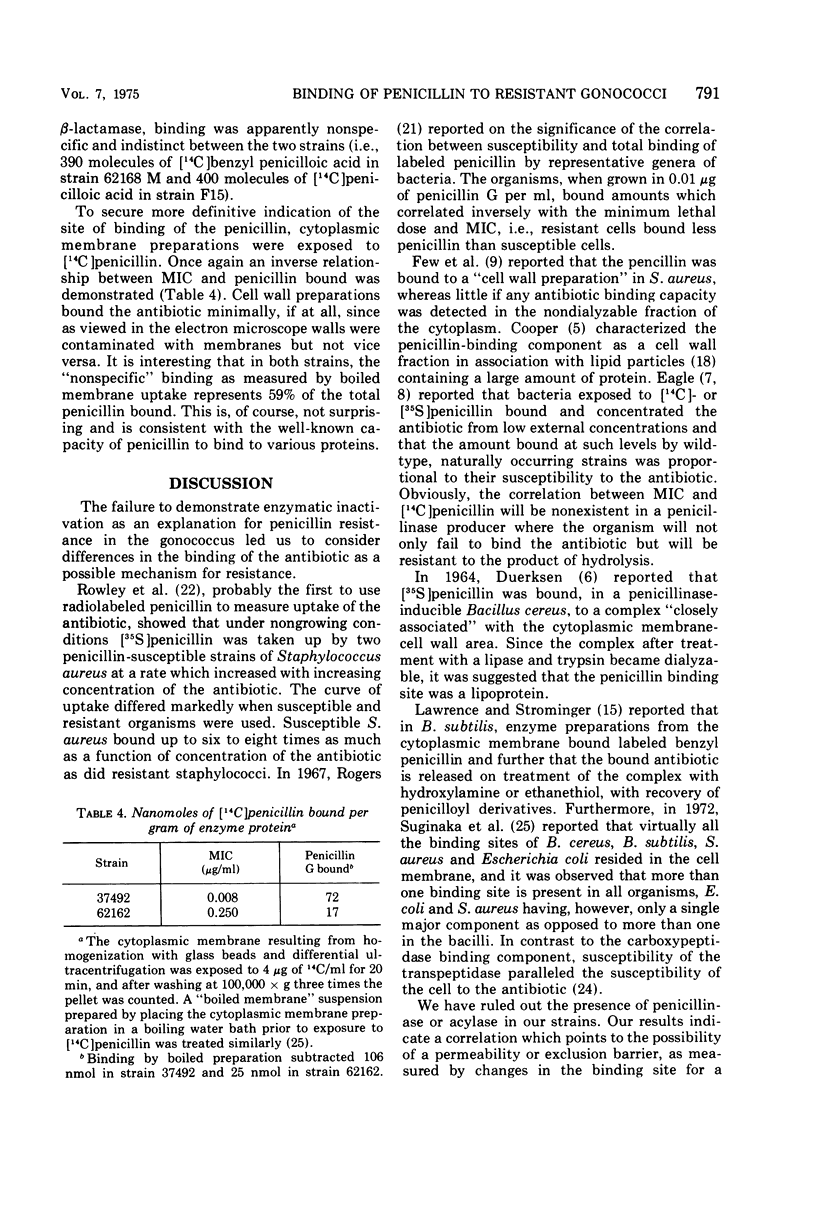
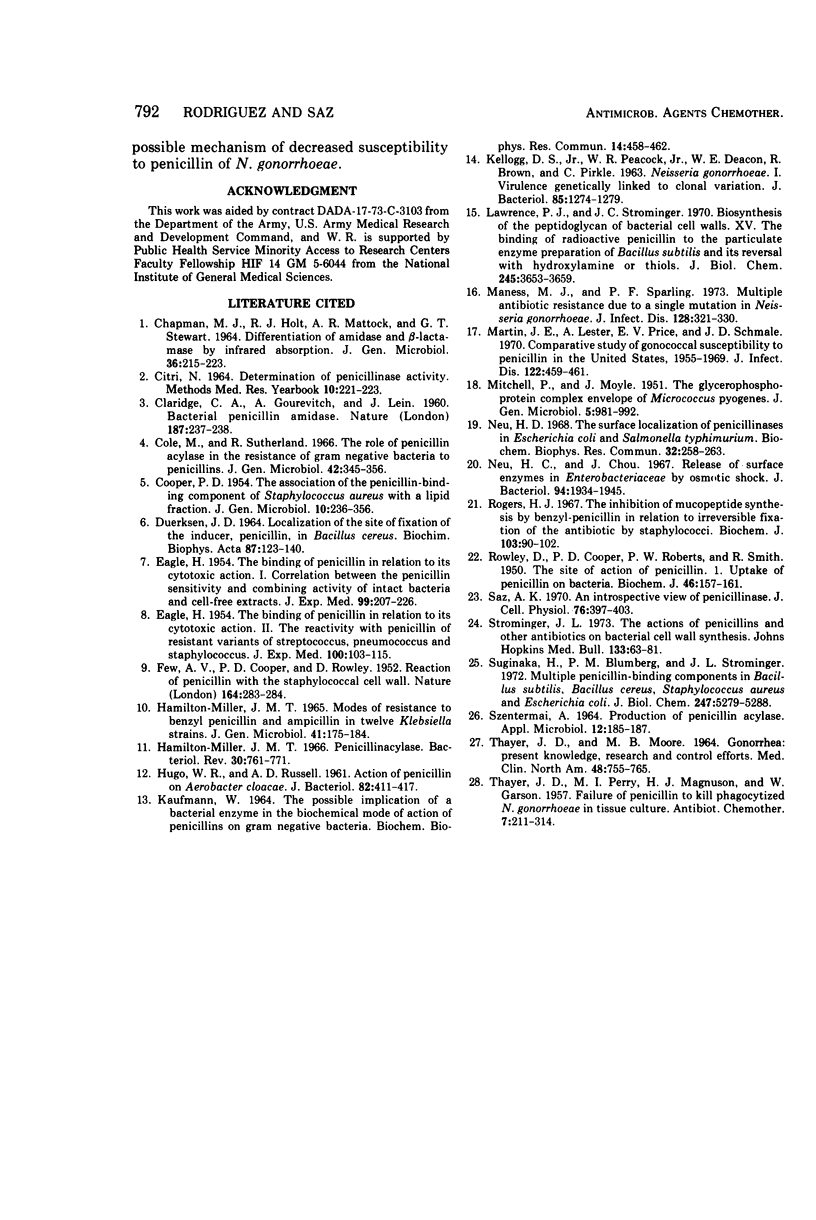
Selected References
These references are in PubMed. This may not be the complete list of references from this article.
- CHAPMAN M. J., HOLT R. J., MATTOCKS A. R., STEWART G. T. DIFFERENTIATION OF AMIDASE AND BETA-LACTAMASE BY INFRARED ABSORPTION. J Gen Microbiol. 1964 Aug;36:215–223. doi: 10.1099/00221287-36-2-215. [DOI] [PubMed] [Google Scholar]
- CITRI N. DETERMINATION OF PENICILLINASE ACTIVITY. Methods Med Res. 1964;10:221–232. [PubMed] [Google Scholar]
- CLARIDGE C. A., GOUREVITCH A., LEIN J. Bacterial penicillin amidase. Nature. 1960 Jul 16;187:237–238. doi: 10.1038/187237a0. [DOI] [PubMed] [Google Scholar]
- COOPER P. D. The association of the penicillin-binding component of Staphylococcus aureus with a lipid fraction. J Gen Microbiol. 1954 Apr;10(2):236–245. doi: 10.1099/00221287-10-2-236. [DOI] [PubMed] [Google Scholar]
- Cole M., Sutherland R. The role of penicillin acylase in the resistance of gram-negative bacteria to penicillins. J Gen Microbiol. 1966 Mar;42(3):345–356. doi: 10.1099/00221287-42-3-345. [DOI] [PubMed] [Google Scholar]
- DUERKSEN J. D. LOCALIZATION OF THE SITE OF FIXATION OF THE INDUCER, PENICILLIN, IN BACILLUS CEREUS. Biochim Biophys Acta. 1964 May 18;87:123–140. doi: 10.1016/0926-6550(64)90053-2. [DOI] [PubMed] [Google Scholar]
- EAGLE H. The binding of penicillin in relation to its cytotoxic action. I. Correlation between the penicillin sensitivity and combining activity of intact bacteria and cell-free extracts. J Exp Med. 1954 Mar;99(3):207–226. doi: 10.1084/jem.99.3.207. [DOI] [PMC free article] [PubMed] [Google Scholar]
- EAGLE H. The binding of penicillin in relation to its cytotoxic action. II. The reactivity with penicillin of resistant variants of streptococci, pneumococci, and staphylococci. J Exp Med. 1954 Jul 1;100(1):103–115. doi: 10.1084/jem.100.1.103. [DOI] [PMC free article] [PubMed] [Google Scholar]
- FEW A. V., COOPER P. D., ROWLEY D. Reaction of penicillin with the staphylococcal cell wall. Nature. 1952 Feb 16;169(4294):283–284. doi: 10.1038/169283a0. [DOI] [PubMed] [Google Scholar]
- HUGO W. B., RUSSELL A. D. Action of penicillin on Aerobacter cloacae. J Bacteriol. 1961 Sep;82:411–417. doi: 10.1128/jb.82.3.411-417.1961. [DOI] [PMC free article] [PubMed] [Google Scholar]
- Hamilton-Miller J. M. Modes of resistance to benzylpenicillin and ampicillin in twelve Klebsiella strains. J Gen Microbiol. 1965 Nov;41(2):175–184. doi: 10.1099/00221287-41-2-175. [DOI] [PubMed] [Google Scholar]
- Hamilton-Miller J. M. Penicillinacylase. Bacteriol Rev. 1966 Dec;30(4):761–771. doi: 10.1128/br.30.4.761-771.1966. [DOI] [PMC free article] [PubMed] [Google Scholar]
- KELLOGG D. S., Jr, PEACOCK W. L., Jr, DEACON W. E., BROWN L., PIRKLE D. I. NEISSERIA GONORRHOEAE. I. VIRULENCE GENETICALLY LINKED TO CLONAL VARIATION. J Bacteriol. 1963 Jun;85:1274–1279. doi: 10.1128/jb.85.6.1274-1279.1963. [DOI] [PMC free article] [PubMed] [Google Scholar]
- Kaufmann W. The possible implication of a bacterial enzyme in the biochemical mode of action of penicillins on Gram negative bacteria. Biochem Biophys Res Commun. 1964;14:458–462. doi: 10.1016/0006-291x(64)90087-7. [DOI] [PubMed] [Google Scholar]
- Lawrence P. J., Strominger J. L. Biosynthesis of the peptidoglycan of bacterial cell walls. XV. The binding of radioactive penicillin to the particulate enzyme preparation of Bacillus subtilis and its reversal with hydroxylamine or thiols. J Biol Chem. 1970 Jul 25;245(14):3653–3659. [PubMed] [Google Scholar]
- MITCHELL P., MOYLE J. The glycerol-phospho-protein complex envelope of Micrococcus pyogenes. J Gen Microbiol. 1951 Nov;5(5 Suppl):981–992. doi: 10.1099/00221287-5-5-981. [DOI] [PubMed] [Google Scholar]
- Maness M. J., Sparling P. F. Multiple antibiotic resistance due to a single mutation in Neisseria gonorrhoeae. J Infect Dis. 1973 Sep;128(3):321–330. doi: 10.1093/infdis/128.3.321. [DOI] [PubMed] [Google Scholar]
- Martin J. E., Jr, Lester A., Price E. V., Schmale J. D. Comparative study of gonococcal susceptibility to penicillin in the United States, 1955-1969. J Infect Dis. 1970 Nov;122(5):459–461. doi: 10.1093/infdis/122.5.459. [DOI] [PubMed] [Google Scholar]
- Neu H. C., Chou J. Release of surface enzymes in Enterobacteriaceae by osmotic shock. J Bacteriol. 1967 Dec;94(6):1934–1945. doi: 10.1128/jb.94.6.1934-1945.1967. [DOI] [PMC free article] [PubMed] [Google Scholar]
- Neu H. C. The surface localization of penicillinases in Escherichia coli and Salmonella typhimurium. Biochem Biophys Res Commun. 1968 Jul 26;32(2):258–263. doi: 10.1016/0006-291x(68)90378-1. [DOI] [PubMed] [Google Scholar]
- Rogers H. J. The inhibition of mucopeptide synthesis by benzylpenicillin in relation to irreversible fixation of the antibiotic by staphylococci. Biochem J. 1967 Apr;103(1):90–102. doi: 10.1042/bj1030090. [DOI] [PMC free article] [PubMed] [Google Scholar]
- Rowley D., Cooper P. D., Roberts P. W. The site of action of penicillin. 1. Uptake of penicillin on bacteria. Biochem J. 1950 Feb;46(2):157–161. doi: 10.1042/bj0460157. [DOI] [PMC free article] [PubMed] [Google Scholar]
- SZENTIRMAI A. PRODUCTION OF PENICILLIN ACYLASE. Appl Microbiol. 1964 May;12:185–187. doi: 10.1128/am.12.3.185-187.1964. [DOI] [PMC free article] [PubMed] [Google Scholar]
- Saz A. K. An introspective view of penicillinase. J Cell Physiol. 1970 Dec;76(3):397–403. doi: 10.1002/jcp.1040760318. [DOI] [PubMed] [Google Scholar]
- Strominger J. L. The actions of penicillin and other antibiotics on bacterial cell wall synthesis. Johns Hopkins Med J. 1973 Aug;133(2):63–81. [PubMed] [Google Scholar]
- Suginaka H., Blumberg P. M., Strominger J. L. Multiple penicillin-binding components in Bacillus subtilis, Bacillus cereus, Staphylococcus aureus, and Escherichia coli. J Biol Chem. 1972 Sep 10;247(17):5279–5288. [PubMed] [Google Scholar]


